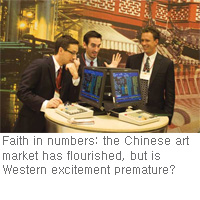 The dodgy numbers game
The dodgy numbers game
If you believe the statistics, as many art indexes and investment funds seem to, China is overtaking the US to become the world’s highest spending art and antiques market. But is this true?
The figures, after a closer look at the reality of the mainland Chinese auction scene, suggest that conclusion is debatable.
The dominant force in the Chinese art market is the auction. Art auctions did not exist in China before 1985; although there were auctions there in the late 19th and early 20th centuries, these were closed down as “capitalist trade” after the establishment of the communist government in 1949. In the mid-1980s, when stamp-collecting was encouraged, philatelists began to trade their collections and stamp auctions proved to be a great success.
In those early days, art auctions were spontaneous and regional, and the sales were quite limited: for example, an auction held by the Beijing Antique Store on 3 June 1988 offered 33 lots, of which only seven sold. The first large-scale, international-style, auction was organised by the Beijing city government and took place in October 1992.
In February 1993, the first art auction house, Shanghai’s Duo Yun Xuan Art Auctioneers, was established under the Shanghai Calligraphy and Painting Publishing House. The same year, China Guardian started up in Beijing; as a limited company it followed the model of Western auction houses such as Sotheby’s and Christie’s. In 1994, the Beijing Hanhai Auction Company was established: its first auction made a then record of Rmb33.4m (at the time, $3.9m).
Within two years, there were nearly 100 art auction companies in mainland China and, according to the Chinese Association of Auctioneers, their turnover was more than Rmb300m ($36m).
In 1996 the Eighth People’s Congress passed the Auction Law of the People’s Republic of China, which formally recognised the legal status of, and gave the framework for, the auction of works of art, including both modern art and “antiques”, such as ceramics and jade. “Modern art” includes paintings and calligraphy by individual artists (not mass productions) from 1919 to the present day; “antiques” comprise any works of art from before 1919, including bronze, calligraphy and paintings.
Since then, Chinese art auctions have grown astonishingly quickly, in particular after 2000, as can be seen in the turnover table below. This is based on figures from the Art Market Research Center (AMRC), an affiliate of the Central Academy of Fine Arts, which produces data for the Chinese ministry of culture.
According to the AMRC, turnover almost trebled in 2010, to Rmb573bn ($91bn), and the recently published statistics for 2011 show an even more astonishing figure of Rmb975bn ($154.2bn). Are we witnessing a miracle in the marketplace?
The answer is no. In the first place, there is no agreement over these figures for 2011. Artron’s influential online Art Market Monitoring Center gives a slightly lower Rmb968.5bn ($148.5bn) for the year. But the Chinese Association of Auctioneers gives a figure of Rmb576bn ($88.1bn). (Artprice, which focuses on fine art sales in the recognised Western sense—ie not “antiques”/crafts—gives a much lower figure for China of $4.8bn, compared with total worldwide fine art sales of $11.6bn.)
How can there be such variations? Which numbers can we trust? The Artron and Art Market Research Center and Chinese Academy of Fine Art figures are very high because they include results from some auction houses that have not removed the (`b_code`,`b_cate`,`b_kind`,`b_title`,`b_name`,`b_link`,`b_content`,`b_etc10`,`b_etc11`,`b_datetime`) VALUES of works subsequently not paid for or discovered to be inauthentic.
The Chinese Association of Auctioneers (CAA) figure is perhaps the most reliable, because it is based on data from the ministry of commerce, but such divergent figures do not inspire confidence.
A better way to understand the Chinese market and its statistics is to look at the individual works of art sold at auctions. Many of the figures are built on false sales and crooked hammer prices. Even in Western auction houses there are have been cases of Chinese bidders who have not paid for their purchases, as with the Qianlong dynasty porcelain vase auctioned at Bainbridges for a world record £51.6m (including buyer’s premium; £43m without) in 2010.
Defaulting is frequent in China: according to the CAA report for 2010, there were 408 lots that sold for at least Rmb1bn ($146m), but only 237 of them were actually paid for (non-payments in 2010 represented Rmb55bn, $8.7bn).
What is more, there is no shortage of forgeries being sold at auction, with extraordinary prices being reported.
Let us take a closer look at Artron’s top ten Chinese older works of art sold in 2011. Number one on the list was a supposedly Yuan dynasty blue and white vase, sold for Rmb685.4m ($108.7m) by a small auction house based in Macau. The same company also sold a purportedly 18th-century imperial porcelain (ranked number nine on Artron’s list) for Rmb191.4m ($30.4m). Both the authenticity of these pieces and their hammer prices have been doubted in China and abroad.
At number seven was a jade chair described as Han dynasty, sold for Rmb220m ($34.9m) at a minor auction house in Beijing. It turned out to be a modern fake and has never been paid for.
Meanwhile, a nude attributed to Xu Beihong (1895-1953) was sold for Rmb72.8m ($20.6m)—number 26 in Artprice’s Top 100 for 2011—and was later exposed as a student’s work.
These are just a few examples to show how difficult it is to see the true picture. While we cannot simply ignore or discard the data, until we have a better grasp of the extent of bad practice among Chinese auction houses, it would be wise to exercise caution and not put too much faith in numbers.
The writer is a senior lecturer in Chinese archaeology at the School of Oriental and African Studies, University of London
 The dodgy numbers game
The dodgy numbers game